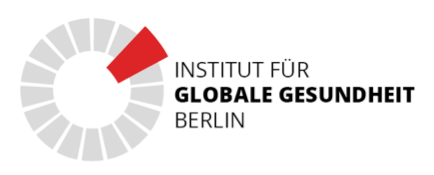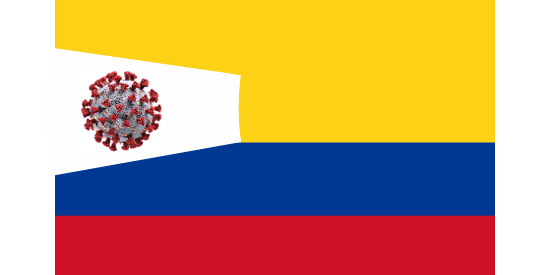AN INSIGHT INTO COVID-19 IN COLOMBIA
By Lina Garnica Rosas, June 20, 2020
Coronavirus disease 2019 (COVID-19) has rapidly increased in the pandemic scale since it first began in Wuhan, China, in December 2019 (1). More than 180 countries have reported cases, including Colombia (2). The Colombian government has established several public health measures to contain the infection and flatten the curve. However, these measures have caused also consequences. This paper describes the current situation in Colombia as the pandemic progresses further in Latin America.
Public health measures
The Colombian National Health Institute reported the first confirmed case of COVID-19 on March 6, 2020. One week later, the Colombian government declared a national health emergency. The initial measures included mandatory isolation for travellers, hygiene and social distancing recommendations for the entire population as well as cancellations of public events. Offices, schools and universities have been closed, home-offices established and online lectures initiated (3).
Following these initial measures, the government implemented even more restricted actions, comprising the closure of airports and borders, and an entire lockdown of stores and businesses. These measures were taken to ensure the national mandatory quarantine, which started on March 24, 2020. During this time, isolation became mandatory and completely restrictive (3). Exceptions applied only for health workers and people with special permissions. Local authorities implemented different rules for their population to allow the acquirement of basic provisions such as food or medicines. For instance, in the capital city, Bogotá, during the first two months of quarantine, women could go out on even days and men on odd days only (4).
The purposes of the lockdown in the country, included to control the infection, to slow down the number of new cases; and to strengthen the health system. Therefore, the government increased laboratory capacity, consolidated medical equipment – 1510 new ventilators were obtained—, increased the production of protective equipment for health workers, and added new patient beds and intensive care units (3).
Current situation
After the establishment of the mandatory quarantine, the government has extended these measures four times already; It has been announced that the lockdown will continue at least until June 30, 2020. From June 1, 2020, the government allowed some of the economic activities again, such as manufacturing and trade force (including some stores and shopping centres). Additionally, the public now has access to outdoor physical activity with restrictions, including divisions by age group and times during the day. Social contact remains restricted, and it is mandatory to use a mask in public spaces, such as public transportation(3).
The social events, bars, night-clubs, restaurants, fitness studios, and cinemas remain closed while home-office work and online education continue. The borders and airports also remain closed, though the intercity-bus routes started to operate gradually – the cases of COVID-19 in each city define the availability of the route—.
According to the latest data reported by WHO, as of June 20, 2020 Colombia confirmed 60,217 cases, within 1,950 dead, and 23,998 cured (3,5). The epicentre appears to be concentrated in the capital (Bogotá); however, other high affected cities are located in the north of the country (Cartagena, Santa Marta y Barranquilla) and, since two weeks the city of Leticia, located in the Amazon region, has presented an increase of confirmed cases (3).
Regarding the capacity of the health sector, until now the intensive care beds within the country have been occupied at an average of 50% (3); however, this percentage varies depending on the region. For instance, Magdalena is in a critical situation as more than 80 % of intensive care beds are currently occupied (6).
The situation for health workers is challenging. Despite the fact that the majority has received support and security through the provision of protective equipment and the implementation of clinical guidelines, some still have to purchase the protective equipment themselves. Admirably and despite all these challenges, the healthcare workforce continues to overcome the situation for the sake of the patients.
Economic effects
The restrictive measures in Colombia have helped flattening the curve, but the partial suspension of the economy has also had a negative impact in many sectors of the country, especially for the small and medium-size businesses. There is an alarming concern as these businesses employ approximately 80% of the formal workers in Colombia(7). The Colombian government has established some subsidies to solve the crisis, but these will – most likely – not be enough.
According to the last statistics, reported in April, 2020 the unemployment rate was 19,8%, a 9.5% increase in comparison to April 2019 (8). A majority of Colombians (8 in 10) had their income reduced since the beginning of the pandemic (9).
Daily food or corona?
The burden of the economic crisis is felt by the entire population but it has disproportionally impacted informal workers, people who work day by day to obtain an income, i.e. street hawkers , and who make up almost half of the Colombian population (12). Due to the lockdown measures and other effects of the COVID crisis, informal workers face major difficulties to fulfil their basic needs like purchasing food and paying rent. Other particularly affected groups include the indigenous, minorities and migrants. Their situation continues to be critical even after the government and NGOs have sent humanitarian aid.
A surprising paradox
Since the end of last year (before the corona crisis), the Colombian government announced a tax-free day planned for June 19, 2020. Though this pandemic has affected the income of Colombians, and the unemployment rate has increased, thousands of Colombians went to stores and shopping centres to take advantage of the sales (10). This situation seems to be contradictory.
Another contradiction remains in the Colombian government, which still promotes the isolation measures, although it allowed the massive assistance of people to stores, overcoming the maximum capacity, and breaking the social distancing. Likewise, this situation reflexes the low adherence of the shoppers to the preventive measures of infection, challenging the isolation rules and the risk of infection.
Violence situation
Due to the lockdown measures, while the number of street crimes such as robberies and homicides has decreased, domestic and gender-based violence has increased. In the first three weeks of the lockdown, the authorities received more than 2,500 phone calls for domestic violence, more than 90% being against women. Sexual harassment and physical aggressions also increased, and 19 femicides were reported in this short period (11).
Solidarity response
The Colombian population is facing difficult scenarios within the COVID crisis, but this has also opened up new opportunities to start different actions to help the people more in need. Different private enterprises, NGOs and foundations have launched strategies to collect economic resources. These strategies include social media fundraising, with the initiative “#AyudarNosHaceBien Unidos Somos Más Fuertes” („To help makes us good, together we are stronger”), and the organisation of online concerts to enforce the individual donations. The collected resources have been destined to supply the necessities of vulnerable communities, such as the delivery of groceries – until today more than 12,000 Colombians have received this benefit. Besides these, other resources have been invested in medical equipment and ventilators to strengthen the medical assistance in neglected regions in Colombia (i.e. Choco) (3,13,14).
Furthermore, during the pandemic crisis, health foundations (i.e. “Fundación Manos Pintadas de Azul”) (15) have organised an online platform to offer free medical consultation for patients in different specialties. This might help to avoid unnecessary visits to hospitals and blockages of emergency departments.
Considerations for the way forward
Colombia has several challenges to overcome due the negative impact of the Corona crisis on several sectors (especially the social and economic sectors). The government needs to strengthen and increase the capacity of the health system and to continue the promotion of public health measures, adapting them over time according to the epidemiologic situation. Government resources should also be allocated to the economic sector in order to seek the reconstitution of small companies, to support informal workers and vulnerable groups and to ensure access of basic needs for everyone. Other key players such as the private sector, major industries and international entities must also take part in the action to heal the damages of the pandemic.
Furthermore, specific and immediate long-term programs are needed to address domestic and gender-based violence in order to decrease the number of cases and protect the women´s rights.
The general population plays the most important role in containing the spread of the disease. It is essential that every Colombian adheres to the recommended preventive measures to create a positive impact for public health.
Author
Lina Garnica Rosas MD, MScIH
Lina is a Colombian physician and epidemiologist from the Rosario University (Bogotá, Colombia) and gynaecologist and obstetrician from Javeriana University (Bogotá, Colombia). In September 2019 she received a postgraduate degree in International Health from Charité University in Berlin.
Contact: lgarnicarosas@gmail.com
References
- Zhou P, Yang X-L, Wang X-G, Hu B, Zhang L, Zhang W, et al. A pneumonia outbreak associated with a new coronavirus of probable bat origin. Nature [Internet]. 2020;579(7798):270–3. Available from: https://doi.org/10.1038/s41586-020-2012-7
- WHO. COVID-19 situation reports [Internet]. 2020 [cited 2020 May 31]. Available from: https://www.who.int/emergencies/diseases/novel-coronavirus-2019/situation-reports
- Gobierno de Colombia. El Coronavirus en Colombia [Internet]. 2020 [cited 2020 May 31]. Available from: https://coronaviruscolombia.gov.co/Covid19/index.html
- The New York Times. Bogotá prohíbe que hombres y mujeres coincidan en la calle en un intento por combatir el coronavirus. 2020 [cited 2020 Jun 5]; Available from: https://www.nytimes.com/es/2020/04/16/espanol/america-latina/cuarentena-bogota.html
- World Health Organization. Coronavirus disease (COVID-19) Situation Report-152 [Internet]. 2020 [cited 2020 Jun 3]. Available from: https://www.who.int/docs/default-source/coronaviruse/situation-reports/20200620-covid-19-sitrep-152.pdf?sfvrsn=83aff8ee_2
- El Tiempo. Coronavirus en Colombia: Ocupación de camas de UCI en el Magdalena superó el 80 por ciento. 2020 [cited 2020 Jun 3]; Available from: https://www.eltiempo.com/colombia/otras-ciudades/coronavirus-en-colombia-ocupacion-de-camas-de-uci-en-el-magdalena-supero-el-80-por-ciento-500934
- Revista Dinero. Porcentaje y contribución de las pymes en Colombia [Internet]. 2016 [cited 2020 Jun 5]. Available from: https://www.dinero.com/edicion-impresa/caratula/articulo/porcentaje-y-contribucion-de-las-pymes-en-colombia/231854
- Departamento Administrativo Nacional de Estadística (DANE). Empleo y desempleo [Internet]. 2020 [cited 2020 Jun 3]. Available from: https://www.dane.gov.co/index.php/estadisticas-por-tema/mercado-laboral/empleo-y-desempleo
- El Tiempo. Colombianos se preocupan más por la ayuda de empresas a trabajadores – Economía -. 2020 [cited 2020 Jun 3]; Available from: https://www.eltiempo.com/economia/colombianos-se-preocupan-mas-por-la-ayuda-de-empresas-a-trabjadores-492854
- The New York Times. What Pandemic? Colombians Shop During VAT-Free Day Amid Coronavirus Quarantine – The New York Times. [cited 2020 Jun 20]; Available from: https://www.nytimes.com/reuters/2020/06/19/world/americas/19reuters-health-coronavirus-colombia-tax.html
- El Espectador. Violencia intrafamiliar en cuarentena, a debate en Senado. 2020 [cited 2020 Jun 5]; Available from: https://www.elespectador.com/noticias/politica/violencia-intrafamiliar-en-cuarentena-debate-en-senado-articulo-922624
- Departamento Administrativo Nacional de Estadística (DANE). Empleo informal y seguridad social [Internet]. 2020 [cited 2020 Jun 3]. Available from: https://www.dane.gov.co/index.php/estadisticas-por-tema/mercado-laboral/empleo-informal-y-seguridad-social
- Unáse al ´vallenatón´ por el Chocó a través de Latinos Unidos – Contenido Patrocinado – ELTIEMPO.COM [Internet]. [cited 2020 Jun 18]. Available from: https://www.eltiempo.com/contenido-comercial/unase-al-vallenaton-por-el-choco-a-traves-de-latinos-unidos-490980
- Solidaridad por Colombia. La Campaña coronatón 10000 sigue su marcha y llega a 3.000 mercados entregados en Bogotá y Medellín. [Internet]. 2020 [cited 2020 Jun 18]. Available from: https://www.solidaridadporcolombia.org/noticias/
- FMPA – F. Manos Pintadas de Azul. FMPA – F. Manos Pintadas de Azul [Internet]. 2019 [cited 2020 Jun 18]. Available from: http://www.manospintadasdeazul.com/quienes-somos/

